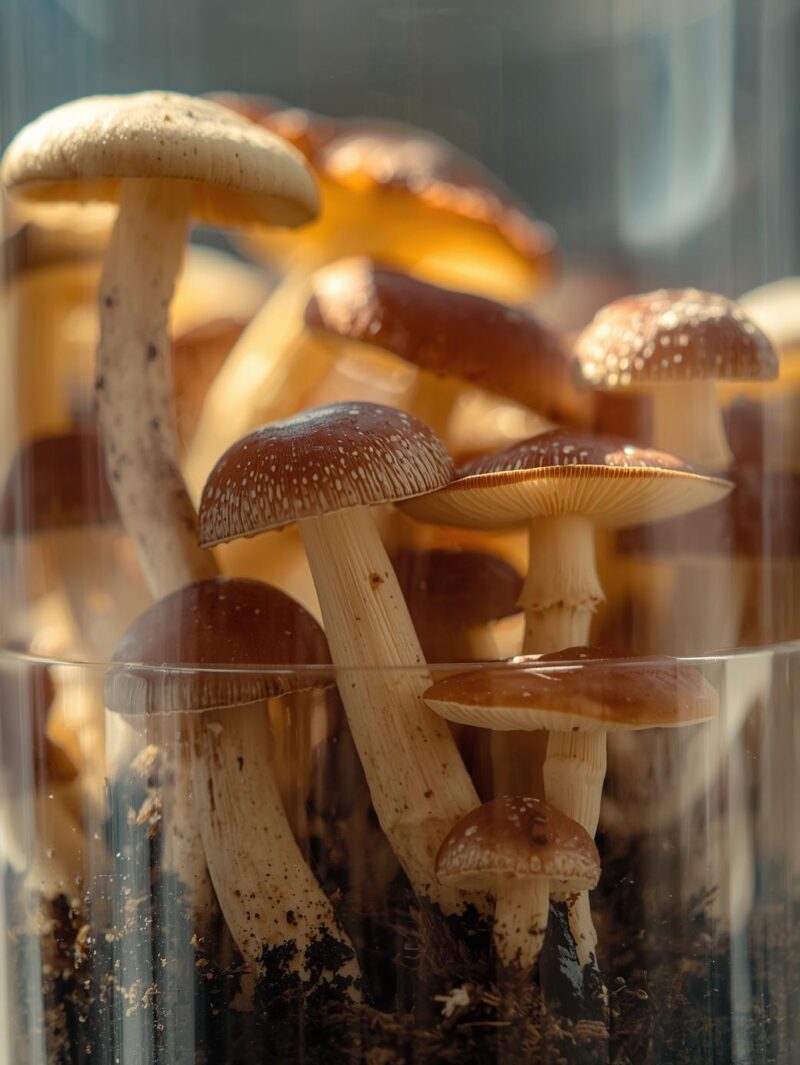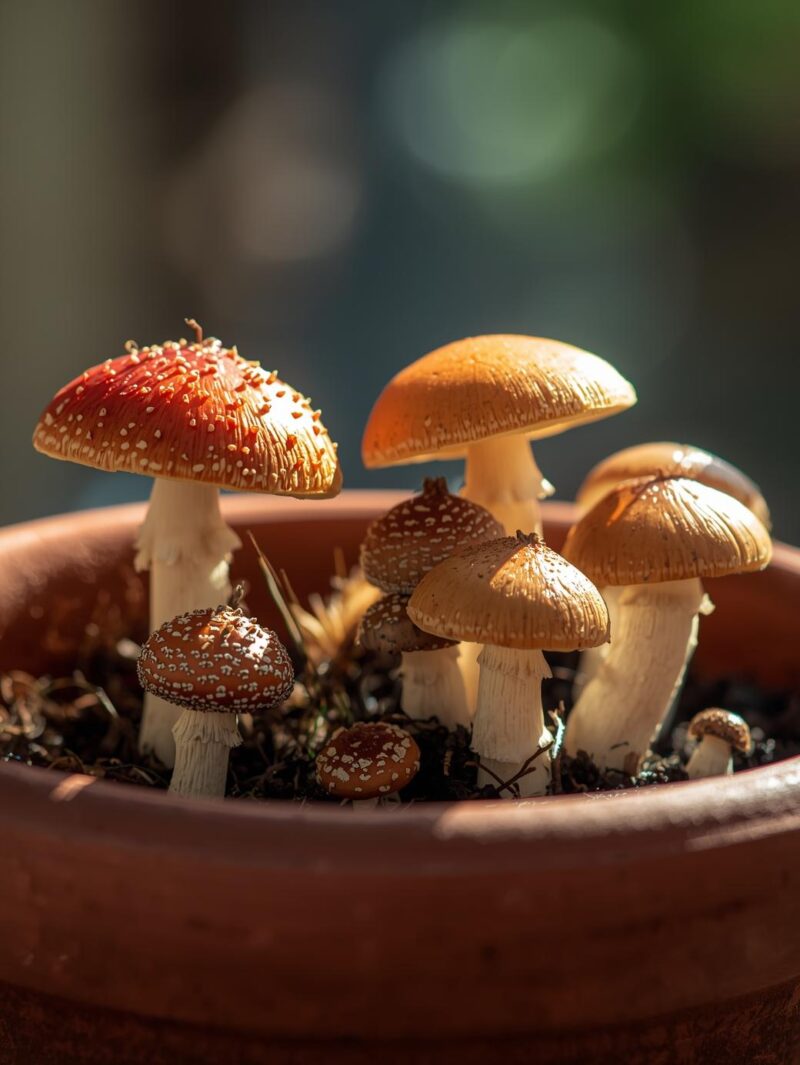Did you know the global mushroom market is set to hit over $69 billion by 2027?
More people are growing their own mushrooms at home.
This is because they want sustainable, nutritious food.
This guide will teach you how to grow mushrooms at home, so you can enjoy a fresh harvest from your space.
Whether you’re new to gardening or have experience, this guide is for you.
You will learn how to grow many types of mushrooms, like button and shiitake.
You will understand the basics of growing mushrooms and how to create the best environment for them.
The Basics of Mushroom Cultivation
Exploring the world of mushroom cultivation, we will look at different methods and key equipment.
These tools help growers cultivate these fascinating fungi at home.
Whether it’s log cultivation or indoor systems, there’s a method for every mushroom enthusiast.
Different Methods of Growing Mushrooms
Log cultivation is a favorite, where mushrooms grow on hardwood logs or sawdust.
It closely mimics their natural habitat, perfect for shiitake and oyster mushrooms.
On the other hand, bag cultivation uses grow bags with a special substrate.
This method is great for indoor growing and saves space.
Essential Equipment and Materials
To grow mushrooms, you need a few important tools. A pressure cooker is key for sterilizing substrates. Grow bags or containers are needed for the mycelium, and humidity controllers keep conditions just right. Choosing the right equipment is crucial for a successful harvest.
Environmental Requirements
Mushrooms need specific conditions to grow well.
Temperature, humidity, and lighting are all important.
Keeping the temperature between 55-75°F is vital for growth.
High humidity, around 90-100%, prevents drying out.
And, the right light helps mushrooms develop strong, flavorful caps.

Types of Mushrooms to Grow for Beginners
Starting to grow your own mushrooms is exciting and rewarding, especially for beginners.
Choosing the right beginner-friendly mushrooms is key.
Some varieties are easy to grow and taste great. Let’s look at some top easy-to-grow mushroom varieties for new growers.
The Oyster mushroom
This type is a favorite for beginners. They grow well in many conditions and use agricultural waste. Their flavor is delicate and slightly nutty, perfect for many dishes.
The Shiitake mushroom
Another great choice for beginners. Known for their rich umami flavor, they’re a staple in Asian cooking. They grow on logs or sawdust, offering a rewarding experience for new growers.
The Button mushroom
A classic choice for beginners. They’re easy to grow and work well in many environments. Their mild, earthy taste is great with many foods.
When picking mushrooms to grow, think about their growing ease, flavor, and nutrition.
Choosing easy-to-grow mushroom varieties that you like can make growing mushrooms a fun journey.
You will enjoy the taste of your hard work.
Selecting the Right Growing Medium and Substrate
Choosing the right growing medium, or substrate, is key for growing mushrooms at home.
The substrate, made from materials like sawdust, straw, or wood chips, gives mushrooms the nutrients and structure they need.
Picking the best growing medium is the first step to a successful mushroom harvest.
Substrate Preparation Techniques
Preparing the substrate properly is crucial for a clean and nutrient-rich environment.
This involves chopping, soaking, and pasteurizing the materials to kill off contaminants.
These steps help create the perfect conditions for mushroom growth.
Sterilization Methods
Keeping the growing area sterile is vital to stop unwanted microorganisms from harming your mushrooms.
Methods like pressure cooking, steam treatment, or chemical disinfection can be used to sterilize the mushroom substrate and growing area.
Using these methods ensures a healthy and productive mushroom growing system.
Optimal Substrate Mixtures
- Sawdust-based substrates: Suitable for species like oyster mushrooms and shiitake mushrooms.
- Straw-based substrates: Ideal for growing lion’s mane and pearl oyster mushrooms.
- Wood chip-based substrates: Preferred for cultivating reishi and maitake mushrooms.
The best growing medium and substrate mix depends on the mushroom species you want to grow.
Knowing the specific needs of each mushroom variety helps you create the perfect substrate mix.
This maximizes their growth and yield.
| Mushroom Species | Optimal Substrate Mixture |
|---|---|
| Oyster Mushrooms | Sawdust, wheat bran, and gypsum |
| Shiitake Mushrooms | Oak or maple sawdust, with added grain and supplements |
| Lion’s Mane Mushrooms | Hardwood chips or pellets, with wheat bran and soybean meal |
By carefully choosing and preparing the substrate sterilization methods, you can create the perfect growing conditions. This leads to a successful and bountiful mushroom harvest.
How to Grow Mushrooms at Home: Step-by-Step Process
Growing mushrooms at home is a fun and rewarding hobby.
The mushroom growing process has several key steps.
These steps, when followed carefully, can lead to a great harvest.
Here’s a detailed step-by-step guide on how to grow mushrooms at home.
Preparing the Substrate
The first step is to prepare the substrate.
This is the base for growing your mushrooms.
You need to pick the right growing medium, like sawdust, straw, or grain.
Then, mix it with the right nutrients and supplements.
Inoculation and Incubation
After preparing the substrate, it’s time to add mushroom spawn.
This is the living culture that starts the growth.
Make sure to spread the spawn evenly in the substrate.
Then, put the inoculated substrate in a controlled area for it to grow and colonize.
Fruiting and Harvesting
When the substrate is fully colonized, it’s ready for the fruiting stage.
This is when mushrooms start to grow. Keep the temperature, humidity, and light right for them to grow well.
Once the mushrooms are big enough, it’s time to harvest them and enjoy your hard work.
During the mushroom growing process, watch the environment closely.
Fix any problems that come up and adjust as needed.
Following this step-by-step guide, you will grow mushrooms at home successfully.
And you will enjoy a fresh and plentiful harvest.
Creating the Perfect Growing Environment
To grow mushrooms well, you need to control the environment closely.
This means managing temperature, humidity, and light.
Let’s look at what makes a great place for mushrooms to grow.
Temperature Control
Keeping the right temperature is key for mushrooms.
Most mushrooms like it between 55°F and 75°F (12°C and 24°C).
If it’s too hot or cold, they won’t grow well or might even die.
Use thermometers and special grow rooms to keep the temperature steady.
Humidity Management
Mushrooms need a lot of moisture, about 85% to 95%. Keeping the air moist helps them grow. Use humidifiers and hygrometers to check and adjust the humidity.
Lighting Requirements
Light is important for mushrooms too.
Some, like oyster mushrooms, do well in the dark. Others, like shiitake, need more light.
Aim for 10-12 hours of soft, indirect light a day. Make sure the light is right for the mushroom you’re growing.
| Mushroom Variety | Ideal Temperature Range | Optimal Humidity Level | Lighting Requirements |
|---|---|---|---|
| Oyster Mushrooms | 55°F to 70°F (12°C to 21°C) | 85% to 95% | Low-light conditions |
| Shiitake Mushrooms | 60°F to 75°F (15°C to 24°C) | 85% to 95% | Moderate to high light intensity |
| Lion’s Mane Mushrooms | 50°F to 70°F (10°C to 21°C) | 90% to 95% | Indirect, diffused lighting |
By watching and adjusting these factors, you can make a perfect spot for mushrooms. Get the right tools and keep improving your setup for great harvests.
Spawning and Colonization Process
The spawning and colonization process is key to growing mushrooms at home.
It starts with adding mushroom mycelium to your growing substrate.
Mycelium is the fungus part that turns the substrate into the mushrooms you eat.
To start, get a good mushroom spawn.
You can buy it or make it yourself in a clean space. After getting your spawn, mix it with your growing substrate.
- Follow the spawn instructions carefully. They can change based on the mushroom and spawn type.
- Mix the spawn evenly into the substrate. This ensures all parts get the mycelium.
- Keep the environment right for mycelium colonization. This means the right temperature and humidity.
The spawn run starts when the mycelium spreads in the substrate.
This can take weeks, depending on the mushroom and growing conditions.
Look for white, cottony growth to know it’s working.
Learning about mushroom spawning and colonization helps you grow great mushrooms.
With patience and care, you’ll soon have tasty mushrooms from your home.
| Optimal Mushroom Spawning Conditions | Ideal Mycelium Colonization Parameters |
|---|---|
|
|
Common Challenges and Troubleshooting
Growing mushrooms at home can be rewarding but comes with challenges.
Growers may face issues like contamination, disease, and pests.
Knowing these challenges and how to fix them is key to a successful grow.
Preventing Contamination
Contamination is a big worry for mushroom growers.
Fungi and bacteria can harm the mushrooms. To avoid this, keep your workspace clean and sterile.
Follow strict cleaning and disinfection rules. Also, watch the temperature and humidity to keep pests away.
Identifying and Treating Disease
Mushrooms can get sick from various pathogens.
Spotting and treating diseases early is crucial. Learn the signs of sickness like color changes or unusual growth.
If you see a problem, act fast. Isolate sick mushrooms and use treatments like fungicides or antibiotics.
Pest Management
Pests like insects and rodents can harm your mushrooms.
Have a plan to manage pests. This might include barriers, repellents, or targeted treatments.
Check your area often for pests. Act quickly if you find any.
By tackling these challenges, growers can succeed and enjoy a good harvest.
Being prepared and watchful is vital for overcoming mushroom growing hurdles.
Harvesting and Storage Techniques
Proper mushroom harvesting is key to keeping your homegrown fungi fresh and flavorful.
When it’s time to pick your mushrooms, handle them gently.
Use the right method for each type. Twist and pull the mushrooms carefully to avoid damaging them.
After picking, think about how to store your mushrooms to keep them fresh longer.
Refrigeration works well, keeping them at 35-45°F.
For even longer storage, consider drying or freezing your mushrooms.
Drying Mushrooms
Drying is a simple way to keep mushrooms for a long time.
Cut the mushrooms thinly and lay them out on a dehydrator tray or baking sheet.
Make sure they have good air flow to dry properly.
This can take a few hours to a day, depending on how thin they are and the drying method.
Freezing Mushrooms
Freezing is another great way to store mushrooms.
Clean and slice them, then briefly boil them to stop them from spoiling.
Cool them down fast in an ice bath, dry them, and put them in airtight containers or bags. This way, they’ll stay good in the freezer for a long time.
| Harvesting Techniques | Storage Methods | Preservation Techniques |
|---|---|---|
| – Gently twist and pull mushrooms from substrate – Handle caps and stems with care |
– Refrigeration (35-45°F) – Drying – Freezing |
– Drying: Slice mushrooms, dehydrate with air circulation – Freezing: Blanch, cool, pack in airtight containers |
Learning how to harvest, store, and preserve mushrooms well means you can enjoy them for a long time. This way, you can savor the fruits of your labor even after the last harvest.

Scaling Up Your Mushroom Growing Operation
As your love for growing mushrooms grows, you might want to turn it into a business. This big step needs careful thought to succeed in commercial mushroom growing.
Commercial Growing Considerations
Scaling up means more space, better processes, and meeting demand. Look at your current setup to find ways to work more efficiently. This will help you grow your operation.
Equipment Upgrades
To grow more mushrooms, you’ll need better equipment.
This includes bigger growing spaces, climate control, and tools for harvesting and packaging.
Keeping up with new mushroom growing tools is key to a smooth operation.
Market Opportunities
Scaling up opens up many mushroom market opportunities.
You can sell to local places, online, or through other channels.
Knowing what people want and what’s popular can help you find the best ways to sell your mushrooms.
Thinking about the commercial, equipment, and market sides can turn your mushroom hobby into a successful business.
With the right plans and investments, you can find new ways to make money and meet the demand for fresh, local mushrooms.
| Consideration | Importance | Key Strategies |
|---|---|---|
| Commercial Growing | High |
|
| Equipment Upgrades | High |
|
| Market Opportunities | High |
|
Conclusion
Growing mushrooms at home brings many benefits, like better nutrition and sustainable food.
You can grow your own mushrooms, enjoying fresh, tasty ones from your home.
This can help you eat healthier or support a greener food system.
In this guide, we covered the basics of growing mushrooms.
We talked about making the right substrate and creating a great growing space.
With our help, you can start growing mushrooms confidently, facing and enjoying the unique parts of this hobby.
Keep learning about mushrooms and join local groups or workshops.
This will help you understand more about these amazing organisms.
With effort and knowledge, you can make the most of growing mushrooms at home.
This way, you’ll help the environment and enjoy the joy of growing your own food.
FAQ
What are the different methods of growing mushrooms?
You can grow mushrooms at home in several ways. Log cultivation, bag cultivation, and indoor systems are popular. Each method has its own needs and works best with certain types of mushrooms.
What essential equipment and materials are needed for mushroom cultivation?
To grow mushrooms, you’ll need a pressure cooker, grow bags, and a humidity controller. A temperature-controlled area is also key. Making sure your substrate is prepared and sterilized is crucial for success.
What are the best mushroom varieties for beginners to grow?
Beginners should start with oyster mushrooms, shiitake, and button mushrooms. These are easy to grow and have specific needs that are great for home cultivation.
How do I prepare the growing substrate for my mushrooms?
Preparing the substrate is vital. Choose the right materials like sawdust, straw, or wood chips. Then, sterilize them to create a perfect environment for your mushrooms to grow.
What are the key steps in the mushroom growing process?
The mushroom growing process includes several key steps. First, prepare the substrate. Then, inoculate it with mushroom mycelium. Next, incubate and finally, allow the mushrooms to fruit. Each step requires specific conditions and techniques for success.
How do I create the perfect growing environment for my mushrooms?
To grow healthy mushrooms, control temperature, humidity, and light. Monitor these factors closely to ensure optimal conditions for your mushrooms.
How do I properly spawn and colonize my mushroom substrate?
Spawning and colonization involve inoculating the substrate with mushroom mycelium. Provide the right conditions for it to spread. This step is crucial for a successful harvest.
What are common challenges in mushroom cultivation, and how can I address them?
Challenges include preventing contamination, treating diseases, and managing pests. Keep your growing area clean, use proper sterilization, and control pests to overcome these issues.
How do I properly harvest and store my homegrown mushrooms?
Harvest your mushrooms at the right time and use the right techniques. This helps preserve their quality and flavor. You can also store them by drying or freezing to extend their shelf life.
How can I scale up my mushroom growing operation?
To grow mushrooms commercially, consider upgrading equipment, infrastructure, and market opportunities. With careful planning and research, you can successfully expand your mushroom growing business.




